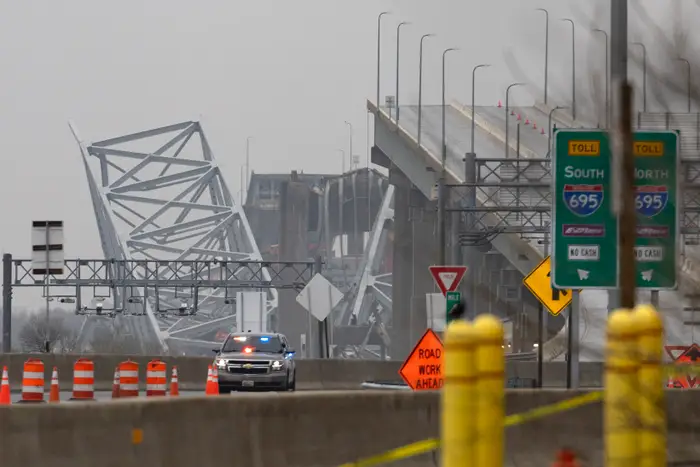6 months after Baltimore’s bridge collapse, lessons are emerging for a rebuild

The Francis Scott Key Bridge in Baltimore collapsed in March after a container ship crashed into it.
A key feature is missing over the Patapsco River in Baltimore. The water still glistens, and cargo ships still pass by on their way in and out of the port. But the Francis Scott Key Bridge, which had spanned the river since 1977, is no longer there.
In March, a container ship crashed into one of the bridge’s piers. The bridge collapsed, killing six people. Rescue efforts began immediately, and local authorities sprang into action to keep commerce and traffic flowing.
Now, six months out, the conversation has shifted from recovery to rebuilding. The Maryland Transportation Authority board approved a $73 million phase-one contract with Kiewit Infrastructure West Co., a firm with a long history of bridge projects. The rebuild is expected to begin next year, with the replacement bridge scheduled to open in fall 2028.
James Harkness, the chief engineer for the Maryland Transportation Authority, told B-17 the phase-one contract was one of the biggest milestones to date on the bridge-rebuilding project.
“We are beginning to meet the new team, get acquainted, and start design concepts in earnest,” Harkness said.
As the project gets underway, insights are emerging on how to reconstruct the Francis Scott Key Bridge to best future-proof the roadway for supporting local transportation and global supply chains. Baltimore project teams could draw from US bridge projects in the recent past and consider new risks in today’s society.
Lessons from bridge to bridge
Baltimore and other bridge tragedies over the years have raised alarms on infrastructure nationwide. For decades, “our nation has sunk into ignoring the status of its bridges,” with maintenance falling by the wayside, said Barry LePatner, a construction attorney, the founder of LePatner & Associates, and the author of “Too Big to Fall: America’s Failing Infrastructure and the Way Forward.”
In its 2021 Report Card for America’s Infrastructure, the American Society of Civil Engineers said that about 46,000 of the country’s bridges, or 7.5%, were in poor condition and that 42% of bridges were at least 50 years old.
The impact of deteriorating infrastructure extends beyond the initial damage from a collapse, reverberating to surrounding communities. In Baltimore, businesses on either side of the bridge took a hit as traffic was redirected to the city’s tunnels and other roads.

An entrance to the Francis Scott Key Bridge in Baltimore after it collapsed.
“If there’s a diner on either side of the bridge that collapsed, those diners don’t have any business,” LePatner said, adding that local businesses and communities could face millions of dollars in “economic harm,” depending on how long repairs and reconstruction took.
The Baltimore bridge collapse reminded many in the industry of a 1980 tragedy in Tampa, Florida, where a freighter struck the Sunshine Skyway Bridge, causing it to collapse. The incident prompted US government officials to publish requirements for new structures in the 1990s, including the addition of fenders to help bridges withstand a ship collision. But older bridges were grandfathered in.
“There are many changes since the late ’60s, early ’70s when Key Bridge was permitted and designed, so we’re going to be meeting or exceeding all of the current standards for the new bridge,” Harkness said.
The Federal Highway Administration classified the Baltimore bridge, along with thousands of others in the US, as “fracture-critical.” This term describes bridges with nonredundant components or connections, meaning the structures rely on individual parts to support them.
“That means if one piece breaks, the entire bridge goes down,” LePatner said.
LePatner pointed to the Governor Mario M. Cuomo Bridge as a standout example, which replaced the Tappan Zee Bridge, north of New York City, in 2018. The Tappan Zee, built in the ’50s, was also fracture-critical and at risk of collapsing.
While the bridge isn’t near a seaport like the Key Bridge, the new Cuomo bridge was “built with all the redundancies,” LePatner said, adding: “It’s state of the art.”
An era of new risk
Some experts view the original construction of Baltimore’s Key Bridge in the ’70s as well done for its time. Vessel traffic was less frequent, and cargo ships were smaller and lighter. Standards didn’t require bridges to account for the risk of ship collision, said Michael Shields, an associate professor in the Department of Civil and Systems Engineering at Johns Hopkins University in Baltimore.
“The risk to major bridges today is very different than it was in the 1970s,” Shields said.
It wasn’t until 2016, when an expansion of the Panama Canal opened, that megaships started to transit the waterways. The newer ships are about 235 feet longer than the older ones, and they can carry 12,000 shipping containers, making them significantly heavier than older vessels transporting 4,500 containers.
“Nobody ever envisioned the size of the ships today,” said Bill Doyle, the CEO of the Dredging Contractors of America and a former executive director of the Port of Baltimore. “The size and the mass and the weight of that ship — it’s taking something down” if it collides with a bridge, he added.
The change to ships, along with growth in global trade and e-commerce, has driven an increase in cargo tonnage at many US ports, including the Port of Baltimore.
Before the bridge collapse, Baltimore’s tonnage hovered around 700,000 container tons a month, Maryland’s Open Data Portal found. Before the Panama Canal expansion, the figures were closer to 500,000. Shields said his research indicated that the Key Bridge was among “the most heavily trafficked bridges for extremely large ships in the US.”
Building for the future
Experts expect the Baltimore rebuild team to consider the risk of ship collision, the construction of redundancies, and ongoing maintenance.
With large, heavy cargo ships going under the bridge, LePatner predicts the eventual Key Bridge may be supported from one end of the ground to the other across the waterway, instead of with piers. That way, in the event of a ship collision, there may be damage but not an entire collapse.
Doyle hopes to see a holistic approach that focuses on the bridge’s engineering and design, as well as the operations of ships passing beneath it. That includes using tugboats to guide massive ships. Doyle said he suspected if tugboats had helped guide the ship in and out of the Port of Baltimore on the day of the crash, the collision may not have happened.
Shields advised doing an assessment of ship-collision risk ahead of the Baltimore rebuild and for future bridge projects. Across the US, “we don’t currently have a good enough understanding of the risks to make informed decisions about what protections are appropriate for a given bridge — new or existing,” Shields said.
As the project gets underway, the lessons learned in conducting risk assessments and designing the bridge could serve as a guide for rebuilding other parts of America’s infrastructure.
“Everyone is watching this project,” Harkness said. “It’s of national and international interest.”






